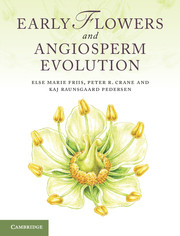Book contents
- Frontmatter
- Contents
- Preface
- 1 Introduction to angiosperms
- 2 The nature of the angiosperm fossil record
- 3 The environmental context of early angiosperm evolution
- 4 Stratigraphic framework and key areas for Cretaceous angiosperms
- 5 Angiosperms in context: extant and fossil seed plants
- 6 Origin and age of angiosperms
- 7 Phylogenetic framework and the assignment of fossils to extant groups
- 8 Fossils near the base of the angiosperm tree
- 9 Early fossil angiosperms of uncertain relationships
- 10 Early fossils of eumagnoliids
- 11 Fossils of monocots
- 12 Fossils of eudicots: early-diverging groups
- 13 Fossils of core eudicots: basal lineages
- 14 Fossils of core eudicots: rosids
- 15 Early fossils of eudicots: asterids
- 16 Patterns of structural diversification in angiosperm reproductive organs
- 17 History and evolution of pollination in angiosperms
- 18 History and evolution of dispersal in angiosperms
- 19 Vegetational context of early angiosperm diversification
- 20 The accumulation of angiosperm diversity
- References
- Index
14 - Fossils of core eudicots: rosids
Published online by Cambridge University Press: 07 September 2011
- Frontmatter
- Contents
- Preface
- 1 Introduction to angiosperms
- 2 The nature of the angiosperm fossil record
- 3 The environmental context of early angiosperm evolution
- 4 Stratigraphic framework and key areas for Cretaceous angiosperms
- 5 Angiosperms in context: extant and fossil seed plants
- 6 Origin and age of angiosperms
- 7 Phylogenetic framework and the assignment of fossils to extant groups
- 8 Fossils near the base of the angiosperm tree
- 9 Early fossil angiosperms of uncertain relationships
- 10 Early fossils of eumagnoliids
- 11 Fossils of monocots
- 12 Fossils of eudicots: early-diverging groups
- 13 Fossils of core eudicots: basal lineages
- 14 Fossils of core eudicots: rosids
- 15 Early fossils of eudicots: asterids
- 16 Patterns of structural diversification in angiosperm reproductive organs
- 17 History and evolution of pollination in angiosperms
- 18 History and evolution of dispersal in angiosperms
- 19 Vegetational context of early angiosperm diversification
- 20 The accumulation of angiosperm diversity
- References
- Index
Summary
Rosids are a very large and heterogeneous group of eudicots that exhibit great diversity in both reproductive and vegetative morphology. The group is recognised based on molecular data, but support is currently weak and there are no unique morphological or anatomical features that define the rosids as a group. Among the shared characters noted by Soltis et al. (2005) is the presence of a reticulate pollen exine, but this is a common feature in many other groups of angiosperms. Other potential defining characters, such as obdiplostemony, mucilage cells in flowers and/or leaves, simple perforations of vessel end-walls, and alternating inter-vessel pitting, are also found occasionally in other groups and their value as synapomorphies of rosids remains to be determined.
Classification of rosids
Core rosids include Vitales, which are sister to two large clades: fabids sensu Judd and Olmstead (2004; Eurosids I sensu APGII, 2003) and malvids sensu Judd and Olmstead (2004; Eurosids II sensu APGII, 2003) (Figure 14.1). Fabids include Zygophyllales, which are sister to the nitrogen-fixing clade, comprising Cucurbitales, Fabales, Fagales and Rosales, and the COM clade, comprising Celastrales, Oxalidales and Malpighiales. Molecular support for these groupings is not strong (Endress and Matthews, 2006a). Malvids include Geraniales + Myrtales, which are sister to the remaining orders (Crossosomatales, Picramniales, Sapindales, Huerteales, Brassicales, Malvales) (APGIII, 2009).
- Type
- Chapter
- Information
- Early Flowers and Angiosperm Evolution , pp. 327 - 360Publisher: Cambridge University PressPrint publication year: 2011

